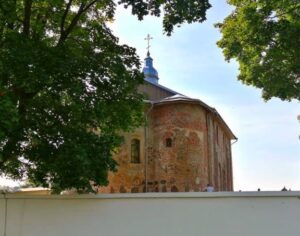10 Famous Cathedrals & Churches In Belarus | Historical Churches In Belarus

- By
- Aparna Patel
- |
- 23 May, 2023
- |
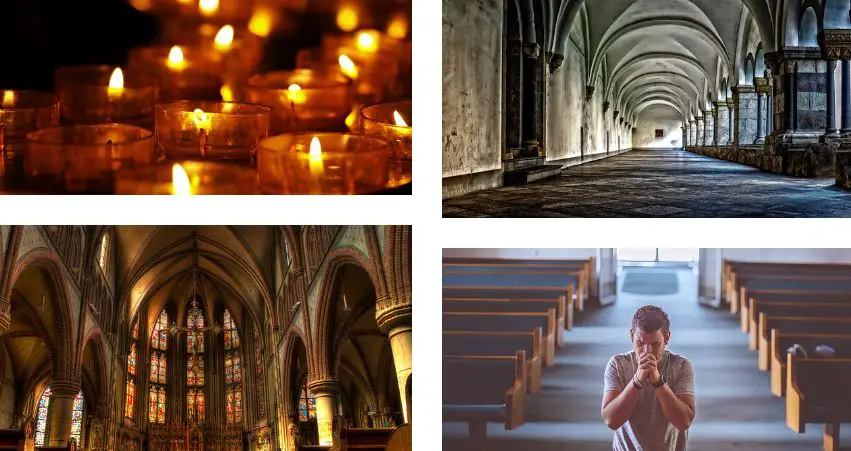
Belarus is home to many stunning and iconic cathedrals and churches, some of which are hundreds of years old. These historical churches tell the story of how Belarusian culture evolved through different political times and how these churches have held a special place in the hearts of Belarusian people.
We’ll take a look at some of the most beautiful and significant churches in the country, and explore their history and importance in the Belarusian landscape.
Famous Historical Cathedrals & Churches In Belarus To Visit
1. Church of Saints Simon and Helena, Minsk
The Church of Saints Simon and Helena is an Eastern Orthodox church located in Minsk, Belarus. It was built between 1902 and 1905 in the Neo-Byzantine style. It is noted for its large red dome, and is the third tallest building in the city. The church is often referred to as Red Church due to the hue of its dome, and is a popular tourist attraction in the area.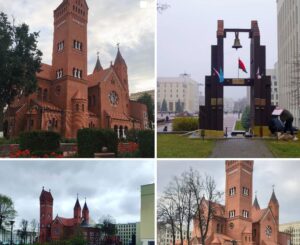
The church was consecrated in 1906, and was granted the status of a cathedral in 1970. It was severely damaged during the German occupation in World War II and underwent a major restoration in the 1990s. The interior of the church contains many icons and murals, and is noted for its gold-plated iconostasis.
The Church of Saints Simon and Helena stands out from the other churches in the city due to its unique architecture and its bright red color. It is a popular destination for locals and tourists alike due to its beauty and historical significance.
2. Cathedral of the Holy Spirit, Minsk
The Cathedral of the Holy Spirit is a Roman Catholic church located in Minsk, Belarus. It is the only Roman Catholic Cathedral in the city and is part of the Roman Catholic Archdiocese of Minsk-Mohilev.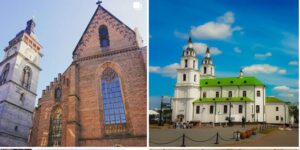
The Cathedral was constructed from 1810 to 1812 in the neoclassical style and stands as a reminder of the republican past of Belarus before its incorporation into the Russian Empire. It is the largest Catholic Church in Belarus and holds services every week in both Latin and Polish.
The Cathedral also houses a number of historical artifacts including several paintings of the Virgin Mary and Jesus Christ. The exterior of the Cathedral has undergone several renovations over the years and is adorned with a pair of majestic bronze lions. The Cathedral is open to the public and is a popular tourist attraction in Minsk.
4. St. Mary’s Church, Volpa
St. Mary’s Church, Volpa is a wooden church located in Volpa in the Grodno region of Belarus. The church was originally constructed in 1820, but underwent a major reconstruction in 1907. The church is a fine example of regional wooden architecture. It has a single tower with an octagonal roof that is topped by a 7m high turret with a cross. Inside the church can be found three wooden icons depicting the Virgin Mary, St. Michael the Archangel, and St Mary Magdalena. They were originally painted in 1932.
Outside the church, there is a cemetery that dates back to the mid-19th century. It is surrounded by a wooden palisade fence and contains many interesting monuments. The cemetery is still in use today, with burials taking place each year.
The church is still active to this day and remains an important place of worship for the local community. It is open to visitors and educates them about the region’s history and culture. It is also a popular destination for visitors exploring the surrounding areas of Volpa.
6. St. Fokas’ Church, Slutsk
St. Fokas’ Church is located in Slutsk, Belarus, and is a historic Orthodox church. The current building was constructed in 1733 and is built in the Baroque style. The church is dedicated to St. Fokas, a patron saint of Slutsk. It occupies an important place in the history of the city, having been restored multiple times over the centuries.
The current structure features two apses, an elaborately decorated tower, and a set of small chapels around the main building. Inside, there are several interesting works of art, including an 18th century iconostasis and an eight-paneled altarpiece. The church is also famous for its ancient pipes, an example of Belarusian architectural style. St. Fokas’ Church is a popular sightseeing destination in Slutsk, and it is open to visitors throughout the year.
7. Cathedral of Saint Sophia ,Polotsk
The Cathedral of St. Sophia, located in the Belarusian city of Polotsk, is one of the most important monuments of Eastern European early medieval sacred architecture. The original church, built in the 11th century, was destroyed in 1486. It was then rebuilt in 1809-1822.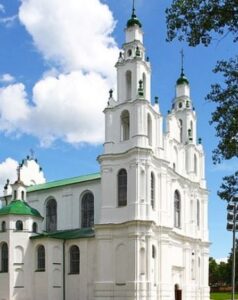
The cathedral is the only surviving pre-Mongolian Orthodox church, and in its present design, the foundation of the walls visible remain from the 11th century original structure.
The Cathedral is still used by the Orthodox Church. It was inscribed in the UNESCO World Heritage List in 2006 and is now a museum. Inside the cathedral are numerous frescoes and icons from the 12th century. There is also an observation platform in the cathedral tower, from which you can see the entire city of Polotsk.
8. Cathedral of St. Trinity, Vitebsk
The Cathedral of St. Trinity is an historic Orthodox cathedral located in Vitebsk, Belarus. The cathedral was built in 1747–1757 by the Russian imperial army on the site of the old 17th century church of St. Barbara and is the most prominent example of late baroque architecture in the region.
The building was designed by the famous Petersburg architect Andrey Voronikhin. It is a three-nave basilica with five domes and is crowned by a large baroque bell tower, which stands forty meters high. Inside the cathedral is adorned with a number of exquisite wall paintings, carved wooden icons, and frescos.
The cathedral is considered a symbol of the city of Vitebsk and is one of the most iconic landmarks in the country. In recent years, the cathedral underwent extensive repairs and now stands in perfect condition, proudly offering its grandeur as a sight of religious worship and cultural heritage.
9. Cathedral of the Exaltation of the Holy Cross (Vitebsk)
This Russian Orthodox cathedral, constructed in the 18th century, is known for its stunning blue-and-white exterior and ornate interior decorations.
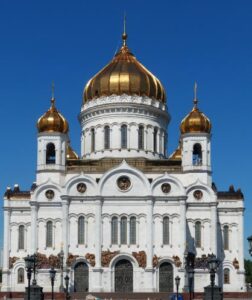
The Cathedral of the Exaltation of the Holy Cross, also known as the Cross-Elevation Cathedral, is a significant religious landmark located in Vitebsk, Belarus. It is one of the notable Orthodox cathedrals in the country and holds historical and cultural importance.
The cathedral was constructed in the 18th century, specifically between 1738 and 1763, in the Russian Orthodox architectural style. Its design features a striking combination of Baroque and Neoclassical elements. The exterior of the cathedral is characterized by its impressive blue-and-white color scheme, intricate ornamentation, and multiple domes.
The interior of the Cathedral of the Exaltation of the Holy Cross is equally impressive. It showcases beautiful frescoes, intricate iconostasis (an ornate screen with religious icons), and various religious artworks. The cathedral also houses a museum dedicated to the history and art of the Vitebsk Eparchy.
Throughout its existence, the cathedral has undergone several renovations and restorations to preserve its historical and architectural integrity. It remains an active place of worship, hosting regular religious services for the Orthodox Christian community in Vitebsk.
The Cathedral of the Exaltation of the Holy Cross is regarded as one of the main attractions in Vitebsk and draws visitors for its architectural beauty, religious significance, and cultural heritage.
10. Kalozha Church of Sts. Boris and Gleb (Hrodna)
Built in the 12th century, this church is a UNESCO World Heritage site and showcases a mix of Romanesque and Byzantine architectural styles.
The Kalozha Church of Sts. Boris and Gleb, also known as the Kolozha Church, is a historic Orthodox church located in Hrodna, Belarus. It is a significant architectural and religious landmark, renowned for its unique blend of Romanesque and Byzantine architectural styles.
The church dates back to the 12th century and is considered one of the oldest surviving buildings in Belarus. It was originally part of an ecclesiastical complex that included a monastery. The church is constructed of red brick, which adds to its distinctive appearance.
The architectural style of the Kalozha Church combines elements of Romanesque and Byzantine influences. The exterior features decorative patterns, arches, and stone carvings, while the interior is adorned with frescoes and religious artwork. The church has multiple domes, including a central dome and several smaller ones.
The Kalozha Church of Sts. Boris and Gleb is a UNESCO World Heritage site, recognized for its historical significance and architectural value. It stands as a testament to the rich cultural and religious heritage of the region.
Today, the church is an active place of worship, hosting religious services for the Orthodox Christian community. It also attracts tourists and visitors who are interested in its historical and architectural significance. The church’s picturesque setting, situated near the Neman River, adds to its charm and appeal.
Search Posts
Latest posts
-
4 Mar, 2024
Why would you wrap your luggage in plastic?
Popular posts
-
5 Mar, 2024
Why prohibit engine braking?
-
5 Mar, 2024
How to avoid drinking vodka?
